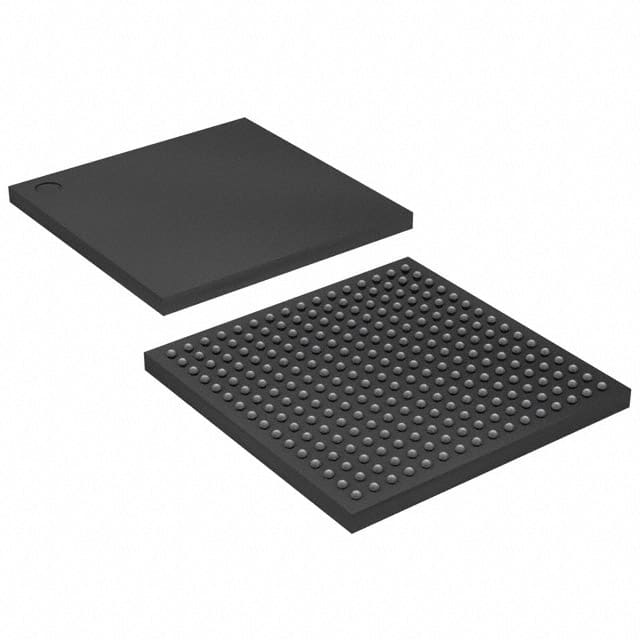EP3C5F256C6
Product Overview
- Category: Programmable Logic Device (PLD)
- Use: EP3C5F256C6 is a PLD used for digital logic design and implementation.
- Characteristics:
- High-performance device with low power consumption
- Offers high-speed performance and flexibility in design
- Provides reconfigurable logic elements and embedded memory blocks
- Package: The EP3C5F256C6 comes in a compact package suitable for surface mount technology.
- Essence: EP3C5F256C6 is an essential component in the field of digital logic design, enabling the implementation of complex digital systems.
Specifications
- Logic Elements: 5,136
- Memory Bits: 256,000
- Maximum User I/O Pins: 179
- Operating Voltage: 1.2V
- Speed Grade: 6
- Package Type: FBGA (Fine-Pitch Ball Grid Array)
- Package Size: 17mm x 17mm
Detailed Pin Configuration
The EP3C5F256C6 has a total of 179 user I/O pins, which are configurable based on the specific requirements of the design. These pins allow for input and output connections to external devices and components. The pin configuration can be found in the product datasheet provided by the manufacturer.
Functional Features
- Reconfigurable Logic Elements: The EP3C5F256C6 offers a large number of logic elements that can be dynamically configured to implement various digital functions.
- Embedded Memory Blocks: The device includes embedded memory blocks that can be used for storing data or implementing memory-based operations.
- Flexible I/O Configurations: With 179 user I/O pins, the EP3C5F256C6 provides flexibility in connecting to external devices and components.
- Low Power Consumption: The device is designed to operate with low power consumption, making it suitable for battery-powered applications.
Advantages and Disadvantages
Advantages: - High-performance device with fast operating speeds - Flexible and reconfigurable logic elements - Embedded memory blocks for efficient data storage - Low power consumption for energy-efficient designs
Disadvantages: - Limited number of user I/O pins compared to higher-end PLDs - Higher cost compared to simpler programmable logic devices
Working Principles
The EP3C5F256C6 is based on the concept of field-programmable gate arrays (FPGAs). It consists of a matrix of configurable logic elements and embedded memory blocks. The device can be programmed using hardware description languages (HDLs) such as VHDL or Verilog. Once programmed, the EP3C5F256C6 can perform complex digital operations by routing signals through the configurable logic elements and utilizing the embedded memory blocks.
Detailed Application Field Plans
The EP3C5F256C6 finds applications in various fields, including:
- Digital Signal Processing: The device can be used to implement signal processing algorithms for audio, video, and communication systems.
- Embedded Systems: EP3C5F256C6 can be utilized in the development of embedded systems, enabling the integration of multiple functions into a single chip.
- Industrial Automation: The PLD can be employed in industrial automation systems for control and monitoring purposes.
- Communications: EP3C5F256C6 can be used in networking equipment, routers, and switches to handle high-speed data processing.
Alternative Models
- EP3C10F256C8: A higher-capacity version of the EP3C5F256C6 with 10,240 logic elements and 256,000 memory bits.
- EP3C16F484C6: A larger variant with 16,384 logic elements and 484 user I/O pins.
- EP3C40F780C7: A higher-end model with 40,960 logic elements and 780 user I/O pins.
These alternative models provide increased capacity and flexibility for more demanding digital logic design requirements.
Word count: 446 words
기술 솔루션에 EP3C5F256C6 적용과 관련된 10가지 일반적인 질문과 답변을 나열하세요.
Sure! Here are 10 common questions and answers related to the application of EP3C5F256C6 in technical solutions:
Q: What is EP3C5F256C6? A: EP3C5F256C6 is a specific model of Field-Programmable Gate Array (FPGA) manufactured by Altera.
Q: What are the key features of EP3C5F256C6? A: EP3C5F256C6 has 5,120 logic elements, 270 Kbits of embedded memory, and supports various I/O standards.
Q: How can EP3C5F256C6 be used in technical solutions? A: EP3C5F256C6 can be used to implement complex digital logic circuits, perform signal processing tasks, and accelerate algorithms.
Q: What programming languages can be used with EP3C5F256C6? A: EP3C5F256C6 can be programmed using Hardware Description Languages (HDLs) such as VHDL or Verilog.
Q: Can EP3C5F256C6 be reprogrammed after deployment? A: Yes, EP3C5F256C6 is a reprogrammable FPGA, allowing for flexibility and iterative development.
Q: What are some typical applications of EP3C5F256C6? A: EP3C5F256C6 is commonly used in industrial automation, telecommunications, image processing, and embedded systems.
Q: Does EP3C5F256C6 require external components for operation? A: Yes, EP3C5F256C6 requires external power supply, clock source, and configuration memory for proper operation.
Q: Can EP3C5F256C6 interface with other electronic components? A: Yes, EP3C5F256C6 can interface with various peripherals and devices through its I/O pins.
Q: What development tools are available for programming EP3C5F256C6? A: Altera Quartus Prime is a popular software tool used for designing, simulating, and programming EP3C5F256C6.
Q: Are there any limitations or considerations when using EP3C5F256C6? A: Some considerations include power consumption, timing constraints, and the need for expertise in FPGA design and programming.
Please note that the answers provided here are general and may vary depending on specific requirements and use cases.


